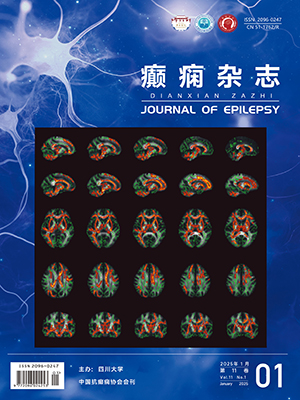| 1. |
van Breemen MS, Wilms EB, Vecht CJ. Epilepsy in patients with brain tumours: epidemiology, mechanisms, and management. Lancet Neurol, 2007, 6(5): 421-430.
|
| 2. |
Chipaux M, Szurhaj W, Vercueil L J, et al. Epilepsy diagnostic and treatment needs identified with a collaborative database involv-ing tertiary centers in France. Epilepsia, 2016, 57: 757-769.
|
| 3. |
Oushy S, Sillauu SH, Ney DE, et al. New-onset seizure during and after brain tumor excision: a risk assessment analysis. J Neu-rosurg, 2018, 128: 1713-1718.
|
| 4. |
Bech KT, Seyedi JF, Schulz M, et al. The risk of developing seizures before and after primary brain surgery of low- and high-grade gliomas. Clin Neurol Neurosurg, 2018, 169: 185-191.
|
| 5. |
Bale, Tejus A, Marc K, et al. The 2021 WHO classification of tumors of the central nervous system: an update on pediatric low-grade gliomas and glioneuronal tumors. Brain Pathology, 2022 : e13060.
|
| 6. |
Blümcke I, Coras R, Wefers AK, et al. Challenges in the histopathological classification of ganglioglioma and DNT: mi-croscopic agreement studies and a preliminary genotype phenotype analysis. Neuropathol Appl Neurobiol, 2019, 45(2): 95-107.
|
| 7. |
Delev D, Daka K, Heynckes S, et al. Long-term epilepsy-associated tumors: transcriptional signatures reflect clinical course. Scientific reports, 2020, 10(1): 96.
|
| 8. |
Koh HY, Kim SH, Jang J, et al. BRAF somatic mutation contributes to intrinsic epileptogenicity in pediatric brain tumors. Nat Med, 2018, 24(11): 1662-1668.
|
| 9. |
Koelsche C, Wohrer A, Jeibmann A, et al. Mutant BRAF V600E protein in ganglioglioma is predominantly expressed by neuronal tumor cells. Neuropathol, 2013, 125: 891-900.
|
| 10. |
Prabowo AS, Iyer AM, Veersema TJ, et al. BRAFV600E mutation is associated with mTOR signaling activation in Glioneuronaltumors. Brain Pathol, 2014, 24: 52-66.
|
| 11. |
Liu Q, Cai L, Sun Y, et al. Epilepsy outcome and pathology analysis for ganglioglioma: a series of 51 pediatric patients. Pediatr Neurol. 2023, 149: 127-133.
|
| 12. |
Qaddoumi I, Orisme W, Wen J, et al. Genetic alterations in uncommon low-grade neuroepithelial tumors: BRAF, FGFR1, and MYB mutations occur at high frequency and align with morphology. Neuropathol, 2016, 131: 833-845.
|
| 13. |
Xie M, Wang X, Duan Z, et al. Low-grade epilepsy-associated neuroepithelial tumors: Tumor spectrum and diagnosis based on genetic alterations. Frontiers in Neuroscience, 2023, 16: 107-314.
|
| 14. |
Suh YY, Lee K, Shim YM, et al. MYB/MYBL1: QKI fusion-positive diffuse glioma. Journal of Neuropathology and Experimental Neurology, 2023, 82(3): 250-260.
|
| 15. |
Kurokawa R, Baba A, Emile P, et al. Neuroimaging features of angiocentric glioma: a case series and systematic review. Journal of neuroimaging, 2022, 32(3): 389-399.
|
| 16. |
Wang H, Zhu J, Zhu P, et al. Angiocentric glioma: a case report and review of the literature. Journal of Clinical Neuroscience, 2021, 94: 179-185.
|
| 17. |
Wefers AK, Stichel D, Schrimpf D, et al. Isomorphic diffuse glioma is a morphologically and molecularly distinct tumour entity with recurrent gene fusions of MYBL1 or MYB and a benign disease course. Acta Neuropathol, 2020, 139: 193-209.
|
| 18. |
Huse JT, Snuderl M, Jones DT, et al. Polymorphous low-grade neuroepithelial tumor of the young PLNTY: an epileptogenic neoplasm with oligodendroglioma-like components, aberrant CD34 expression, and genetic alterations involving the MAP kinase pathway. Acta Neuropathol, 2017, 133(3): 417-429.
|
| 19. |
Hinojosa J, Victoria Becerra V, Candela-Cantó S, et al. Extra-temporal pediatric low-grade gliomas and epilepsy. Childs Nerv Syst, 2024, 40(10): 3309-3327.
|
| 20. |
Rosemberg S, Fujiwara D. Epidemiology ofpediatric tumors of the nervous system according to the WHO 2000 classification: a report of 1195 cases from a single institution. Childs Nerv Syst, 2005, 21(11): 940-944.
|
| 21. |
Collins VP, Jones DT, Giannini C. Pilocytic astrocytoma: pathology, molecular mechanisms and markers. Acta Neuropathol, 2015, 129(6): 775-788.
|
| 22. |
Ryall, Scott, Zapotocky, et al. Michal integrated molecular and clinical analysis of 1, 000 pediatric low-grade gliomas. Cancer cell, 2020, 37(4): 569-583.
|
| 23. |
Xing H, Song Y, Zhang Z, et al. Clinical characteristics of BRAF V600E gene mutation in patients of epilepsy-associated brain tumor: a meta-analysis. J Mol Neurosci, 2021, 71: 1815-1824.
|




